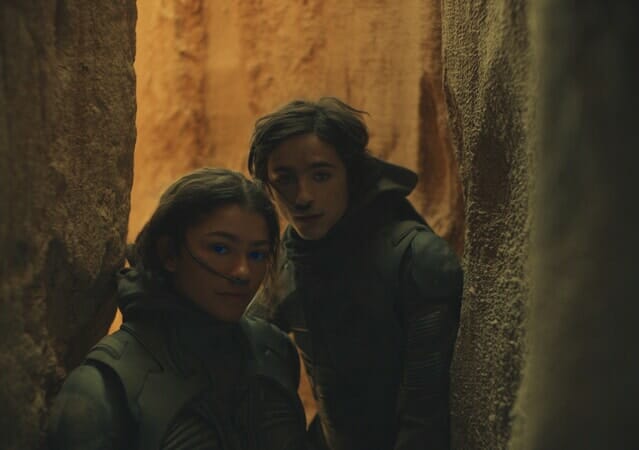
Dune | A grounded Sci-Fi reaching for the Stars
Year
Runtime
Director
Writer
Cinematographer
Production Designer
Music by
Country
Format
Genre
Subgenre
Dune: Part One is a science fiction movie directed by Denis Villeneuve from a screenplay he co-wrote with Jon Spaihtsand Eric Roth. The movie had its world premiere at the 78th Venice International Film Festival before being released in theaters in late 2021.
Its appeal stems from a unique insight into a depiction of the future. Villeneuve crafted a humble, realistic, and organic vision of a story set on an alien and distant planet. The choices made for sound, visual, and set design all reflect this need for realism in an extraterrestrial context. This paradox offers a refined and refreshing take on a sci-fi movie.
The resurrection of a cult classic
Dune is an adaptation of what is considered one of the world’s best-selling science fiction novels. Indeed, the movie covers the first half of the novel of the same name written by Frank Herbert in 1965. The background narrative provides insights into astrobiology, while its core plays out on the geopolitical, economic, and spiritual dynamics of an interstellar civilization.
David Lynch also directed an adaptation of Dune in 1984. Although it was a commercial failure, it pleased many of the amateur fans with spectacular universes. Indeed, it had one of the biggest budgets of the decade, but its impact deceived the U.S. box office. The director was not totally responsible for this; the producers limited his creative freedom. Many scenes were cut out and the screenplay was rewritten several times. The young Villeneuve, an admirer of Herbert’s work, felt that something was missing in this adaptation. So, he felt he could give it a go and try to please that inner fan.
The Prophecy and the Boy
The year 10191. Humankind has spread throughout the universe and lives in a feudal society. The “spice” is the most precious commodity, which can only be found on the planet Arrakis. Dune tells the story of Paul Atreides (Timothée Chalamet), a gifted young man, son of the noble Duke Leto (Oscar Isaac) of House Atreides. His mother Lady Jessica (Rebecca Ferguson) bestows upon Paul a darker legacy. As a “Bene Gesserit”, she instructs him on the path to sisterhood filled with ancient and powerful knowledge.
When the Padishah Emperor entrusts control of Arrakis to House Atreides, the members of House Harkonnen, the previous exploiters, enraged wage a war to take it back. Fortunately, Paul and his mother escape the war. They take refuge in the desert, where they cross the path of Chani (Zendaya) and the Fremen people. They decide to join their mythic journey and their fight against the Harkonnen oppressors.
An immersive soundscape
Hans Zimmer composed the soundtrack, tailoring it to Dune‘s epic universe. The soundscape subtly waves layers of melodies and sound effects together, creating a complete world. For example, tribal drum beats are synchronized with the sound of footsteps as the Harkonnens make their entrance. This proved to be a challenge at a time when viewers had many preconceptions about the sci-fi genre. Notably, the Star Wars sound effects shaped a future populated by beeping machines; hovering space crafts; and laser artillery combat. Another type of futuristic aesthetic is the heavily synthesized Daft Punk soundtrack made for Tron: Legacy (2010).
However, Dune‘s sounds do not tap into this rich library, offering instead something completely new. The first reason for its success is the harmonious relationship that exists between the sound designers and the composer. Villeneuve encouraged Hans Zimmer and sound designer Marc Mangini to collaborate intensively. The communication between the departments is very evident here. The second reason is that these two were working on the movie early in the process, instead of operating in post-production. This constant back and forth allowed them to influence each other’s work, which subsequent melded into a coherent soundscape.
One other key decision the director made was to produce a sound design that was naturalistic. Although Dune is completely alien, its sounds and landscapes are not so foreign. For example, the ornithopters’ sound is based on the flight movement of a beetle. Indeed, Mangini said in an interview with the Dolby Institute that they knew it had to be organic, but they did not want to sound like a helicopter or anything familiar on an earthly level.
Sober yet grandiose visuals
Villeneuve also chose a grounded, realistic direction for the on-screen visual effects. VFX supervisor Paul Lambert uses them only to enhance the effects of observable events, such as wind or sand flowing massively on the planet Arrakis. For example, ripples in the sand suggesting a worm crawling underneath replicate the liquefaction phenomenon. Indeed, the God-worm is a giant compared to the grain of sand, so its movements are likened to the elegance of a whale moving underwater. The teams created this effect practically with a metal plate that vibrated under the sand. Then, VFX artists digitally produced images to expand the flowing sand. Because they worked closely with references to match the actual footage, the visual effects look natural.
All scenes that take place outdoors are actually filmed on the exterior to capture natural sunlight. This allows the stark contrast of real shadows to be captured, even on large sets. In addition, cinematographer Greig Fraser opted to use “sand screens” to surround the set, instead of conventional green screens, so that the reflective light on faces and objects matches the Dune‘s desert landscapes. Also, an overall factor that makes the movie feel more grounded is Villeneuve’s decision to center scenes around the characters. The director restrained the shots in order to always look at objects in relation to people for scale, or from the characters’ perspective.
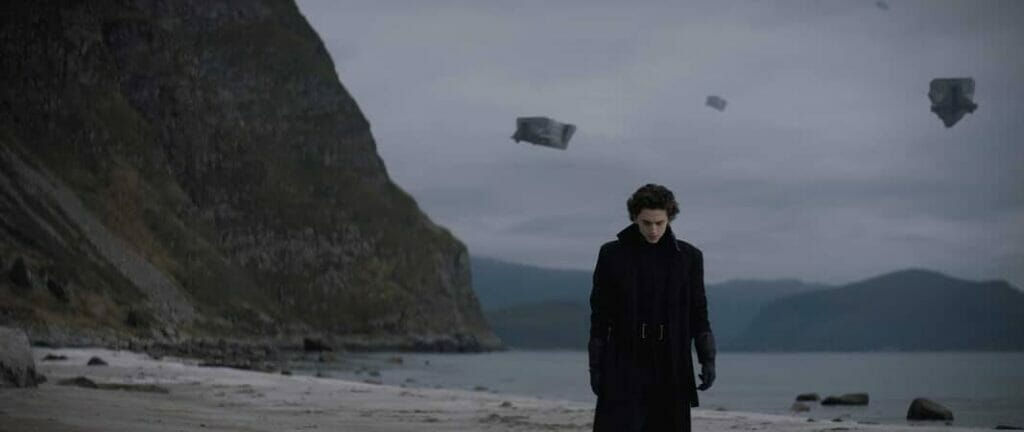
A set designed for a concrete outdoor space
Architecturally, the setting draws inspiration from the Brutalist movement. Brutalism qualifies colossal buildings with vertical facades and a monochromatic palette that enhances the concrete’s raw look. This choice is not accidental; the concept art of David Lynch’s Dune is reminiscent of Brutalist design. Also, there are similarities with Villeneuve’s previous movie Blade Runner 2049.
Production designer Patrice Vermette stuck to the novel’s description of the environment to shape the production set. In addition, Vermette stated he listened to English rock band Joy Division a lot while designing; songs like Atmosphere that filled him with heaviness. For example, the novel mentions that the wind on Dune can travel at 850 km per hour. So, Vermette envisioned the buildings on an angle so that the wind could sweep over them. And indeed, the new home of House Atreides in Arrakeen is a gargantuan pyramid structure that protects them from the burning sand and heat. Only cracks in the blocks let the bright lights into the building.
Once again, Vermette and his team made sure the Dune universe was realistic. Viewers experience something out of this world, yet the set allows them to create a space that has its own reality.
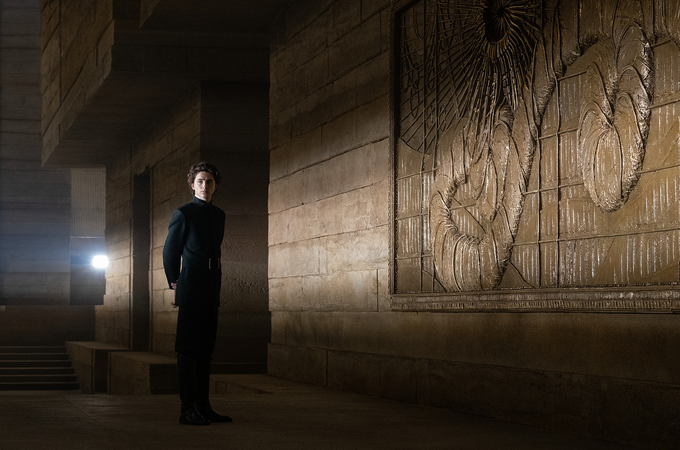
Costume Design: sobriety and elegance
Patrice Vermette also created a book with sketches of each set, with all the decoration elements and costumes. Jacqueline West and Robert Morgan designed the costumes. Whether it is the battle gear or the regal costumes, both styles are elegant and defy excess. Once again, this department anchored their work in reality. West and Morgan explored how the peoples of Jordan and Afghanistan dressed for protection in the harshest deserts. Moreover, the Fremens’ blue eyes are reminiscent of the indigo turban worn by Tuareg men.
Another resource that helped create real-looking outfits was digging into the past. Indeed, West is an expert in creating historical costumes and looked to the Medieval era for inspiration. For example, they used Giotto‘s paintings as a reference for Lady Jessica’s iconic ocher gown, which she wears upon her arrival on Arrakis. The actress’ face is also covered by a handmade chain-link structure, giving her a mixed medieval and tribal look. However, the costume designers also tried their hand at a more modern fashion to add a futuristic touch. Hence, Paul Atreides’ slim black costume draws inspiration from a Balenciaga collection.
Finally, the scale of the work is remarkable. They actually created 250 of the delicate “stillsuits”. It is no surprise that West and Morgan won the Costume Designer Guild Award for Excellence in Fantasy Film and earned a nomination for the Academy Award for Best Costume Design.
Dune also received a nomination for the Academy Award for Best Makeup and Hairstyling. Actor Stellan Skarsgårdhad to sit through monstrous seven-hour sessions for Baron Vladimir Harkonnen’s makeup. In particular, his face and neck construction was very delicate and perfectly hideous.
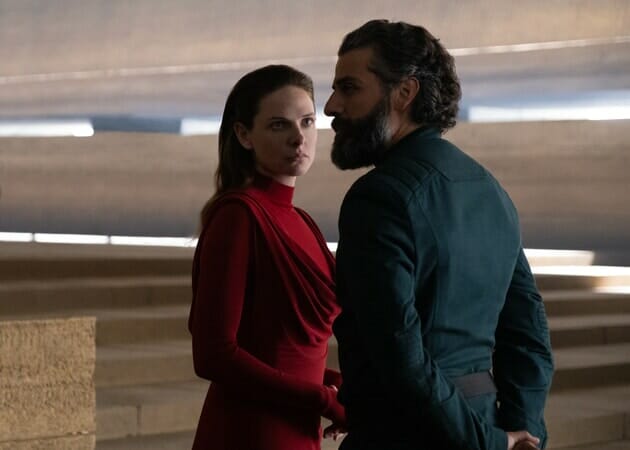
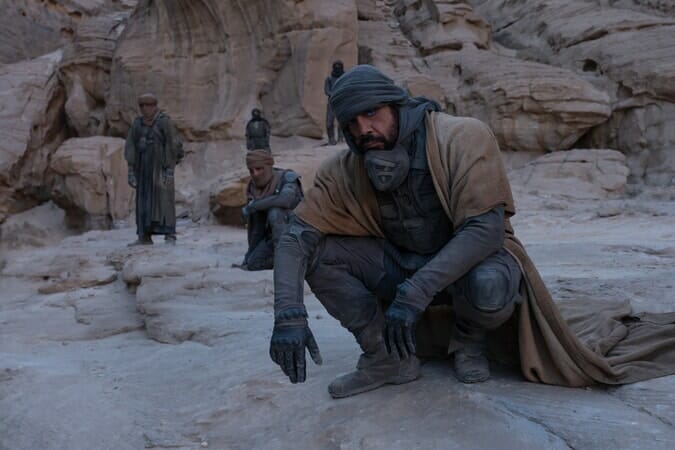
Dune is setting a new standard
In conclusion, Villeneuve succeeded in shaping a science fiction universe that appears authentic and proves to meticulously adhere to the descriptions of Herbert’s novel. And he has accomplished this mainly thanks to the teamwork and great communication carried out by the various departments. As proof of this, at the 94th Academy Awards, Dune earned 10 nominations, including Best Picture; Best Adapted Screenplay; Best Visual Effects; and Best Cinematography.
This stands in sharp contrast to fantasy production such as Avengers, where filming with VFX allows the camera to defy the rules of gravity and lighting. Dune shows an alternative that feels fresh, with an undeniable new aesthetic that is here to last. The only question is: will the impact of the Dune saga be as significant for the next generations as Stars Wars has been for the past ones?
Tag
Buy a ☕ for Hypercritic








